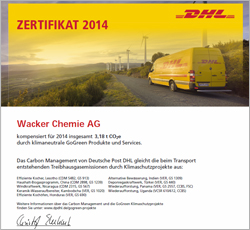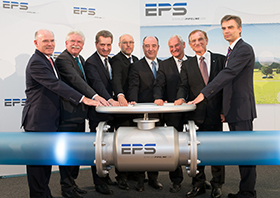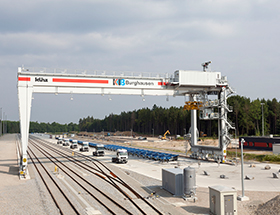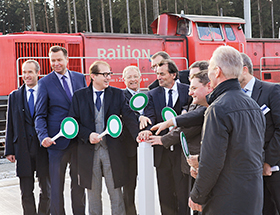Logistics and Transport
We constantly strive to improve our processes in order to optimize logistics chains and minimize shipment journeys or avoid unnecessary ones. Our Logistics department uses a simulation system to help us analyze the flow of goods. We can use this system to calculate carbon dioxide emissions and determine the potential for optimizing transport routes and vehicle capacity utilization. We use electronic systems to organize in-plant transportation such that routes are short and wasted empty space is avoided. As well as checking carbon dioxide levels, we monitor noise emissions from the vehicles we use for our shipments.
To monitor our journeys, we also follow the “guidelines for determining the carbon dioxide emissions associated with logistics operations” (German language only) issued by the German Chemical Industry Association (VCI). Wherever possible, we are switching from road to rail transport. Today, the majority of the freight containers leaving our German sites are transported by rail to North Sea ports, in particular. Since 1999, WACKER’s 600-meter long container train has traveled every day from Burghausen to the ports in Bremerhaven and Hamburg. In Burghausen, we now transport more than 95 percent of container shipments by rail, which means that almost 12,000 freight containers a year no longer travel to ports by road. Our container trains between Burghausen/Nünchritz and the ports of Bremerhaven and Hamburg replace around 25,000 road journeys a year. This saves around 2,100 metric tons of carbon dioxide annually.
At its production sites, WACKER processes raw materials from all over the world. We have developed a strategy for our supply chains that allows us to coordinate capacities for raw-material deliveries and exports, and to avoid empty space in containers. In addition, in our collaboration with shipping companies, our tendering for overseas imports and exports run in parallel. This allows us to assign containers for our raw-material deliveries that belong to the same shipping company portfolio that we use for exports. The raw materials enter our train system in Hamburg; after the journey, the containers are unloaded at our sites and then loaded again directly for export. Transport of intermediates between our sites follows the same concept.
Burghausen Logistics Hub
Shipping volumes increased in the period under review. As the Group’s largest logistics hub, Burghausen has increased its shipping volume by about 2 percent to around 762,000 metric tons (2013: 750,000 metric tons). There was a slight rise in the number of both truck loads and overseas containers – up to 40,700 and 12,500, respectively.
Transport Volumes for the Burghausen Logistics Hub


Most of the freight containers leaving our German sites reach northern ports via rail. From our Nünchritz site, some 5,800 containers are transported to German seaports by rail and inland waterways from Riesa every year. When we procure raw materials, they are primarily transported by rail, too. Over shorter distances, however, truck transport is still more cost-effective and thus indispensable.
Climate-Neutral Transport

Deutsche Post DHL certified WACKER with its GoGreen certificate in 2013 and 2014.
With the GoGreen certificate, our logistics service provider Deutsche Post DHL certifies the offsetting of greenhouse gas emissions generated by the transport of our parcels. The greenhouse gas emissions specified on the certificate of 3.18 metric tons CO2e in 2014 include emissions from transport and logistics, as well as upstream emissions from fuel and energy generation (2013: 2.76 t CO2e). CO2 equivalents (CO2e) include carbon dioxide (CO2) and other greenhouse gases, such as methane (CH4) and nitrous oxide (N2O).
Deutsche Post DHL’s carbon management is offsetting the greenhouse gas emissions generated during transport in the period under review through investments in global climate-protection projects. The SGS (Société Générale de Surveillance) has verified the calculated greenhouse gas emissions and their compensation in accordance with carbon management systems and the “Greenhouse Gas Protocol – Product Lifecycle Accounting and Reporting Standard.”
Reducing Shipment Routes
In integrated production, we transport products and byproducts from one plant to neighboring facilities by pipeline. For large quantities, the transport of products by pipeline is cost-effective, safe and emission-free. Ethylene, one of our most important raw materials, is piped to our Burghausen site from the adjacent OMV Deutschland site.
WACKER BIOSOLUTIONS’ transfer of its CGTase production from Burghausen to the US Eddyville site in 2012 contributed to savings in transport emissions (Scope 2) during the reporting period. CGTase (cyclodextrin glycosyl transferase) is an enzyme used in the manufacture of cyclodextrins, such as our CAVAMAX® and CAVASOL® products. CGTase now no longer needs to travel from Europe to Asia in a container ship, but can be processed directly into cyclodextrins in Eddyville.
Our Nünchritz plant obtains cartridges for silicones from a packaging manufacturer in nearby Grossenhain. Burghausen procures reusable IBCs (intermediate bulk containers), drums and pallets from regional suppliers. We have replaced 220-liter drums for shipping silicone fluids and emulsions with 1,000-liter IBCs. WACKER fills over 130,000 of these containers annually, and then sends them to a service provider a short distance away, where they are recycled.
Short distances to service providers and maximum avoidance of empty space in the containers help to minimize emissions and waste. We are implementing similar measures at our sites in China, Japan and the USA. As an alternative to tank containers and IBCs, we also use flexitanks to transport liquids to Brazil, China, India and the Middle East, for example. WACKER mounts the flexitanks in containers in such a way that, once the flexitank has been emptied, the container can be used for another cargo straight away, without having to be cleaned first.
Piston tanks are an environmentally sound alternative to transport drums for viscous products such as our silicone sealants. A moving internal piston pushes 25 metric tons of silicone sealant – equivalent to 125 steel drums – into the tank semitrailer during loading. Customers can connect the tank directly to their filling equipment and the piston pushes the product out of the tank. Several thousand metric tons of silicone sealant currently leave our Burghausen site in this way. WACKER’s sites outside Germany, too, procure mainly from regional suppliers to shorten transport distances.
We exchange electronic data with our shipping agents so that they can plan their trips as efficiently as possible and ensure their vehicles are always fully loaded. Plus, we launched a strategy back in 1996 to help avoid empty runs by focusing on regional shipping agents. It enables the agents responsible for a particular postal code area to plan return journeys in their region so that trucks are almost never partially laden. Our annual assessment of shipping agents extends to their environmental performance. For example, we ask how their vehicles are rated in European emission standards (such as the Euro 5 exhaust emission standard). The number of Euro 5 compliant vehicles used by our logistics providers has increased from just under 8 percent in 2006 to over 83 percent in 2014.
Expanded Transportation Infrastructure at Our Sites
For the construction of the new polysilicon facility at Charleston (Tennessee, USA), project logistics already take account of operational requirements. The infrastructure that was put in place will be used during plant start-up, and for subsequent supply and waste-disposal operations. In 2014, polysilicon expansion continued at the Charleston site. Project logistics are playing a central role in ensuring that plant components arrive for assembly at the right place and right time. In parallel to this, the logistical processes for start-up and production are being developed.
At the Zhangjiagang site, we are constructing a new logistical storage and distribution center to handle the ever-growing volumes of incoming and outgoing raw materials and finished products even more efficiently. Completion of this project at the Chinese site is scheduled for fall 2015.
Operations at the new public combined road and rail terminal in Burghausen commenced in the fall of 2014. In addition to expediting container traffic for exports, we are working with the operator to shift more freight from road to rail using the new terminal. The combined road and rail terminal has been linked to the site via the new North Gate for trucks, which will make shipments into and out of the Burghausen site quicker and easier.
Ethylene Pipeline South Started Operation
The Ethylene Pipeline South (EPS; German-language website only) was started up in 2013. It enables the safe and economical transport of ethylene between major southern German chemical sites and up to Rotterdam (Netherlands). Construction began in 2007. For the EPS, a 370-km long pipeline runs west from Münchsmünster in Bavaria across Baden-Württemberg to Ludwigshafen in Rhineland-Palatinate. The pipeline enables ethylene to be transported without emissions and at very low energy costs. Once the construction work has been completed, the EPS will be virtually invisible and will have no adverse effect on the landscape. Pipelines were not laid in protected areas where drinking water is abstracted or mineral springs are located, and were only installed in significant water management areas if special safety precautions were put in place.

A ceremony in Munich in July 2013 marked the official opening of the EPS (Ethylene Pipeline South).
Expansion of Transport Routes to ChemDelta Bavaria
In the ChemDelta Bavaria area, one of the major infrastructure projects is the electrification of the rail route to Munich and its expansion to two tracks. This project is making good progress. Previously, the rail line to Burghausen had been in the same condition as in 1897, with the exception of a few enhancements over recent years. One bottleneck is the section between Altmühldorf and Tüßling, where three rail lines meet; around 1 percent of German freight traffic passes over these tracks. Construction has already started at this bottleneck; it is scheduled to be removed by 2017.
Expansion of the A 94 Munich to Passau autobahn – supported by the ChemDelta Bavaria association of companies – is progressing. The call for bids as part of a PPP (public-private partnership) project – which is securing the funding for the stretches from Pastetten to Dorfen and Dorfen to Heldenstein – is expected to result in the awarding of the contract in 2015. This means that a continuous autobahn from Munich to Marktl can become a reality by 2018/2019 at the earliest. Completion of the A 94 would not only improve the transport infrastructure of ChemDelta Bavaria, but also relieve congestion in villages and towns along the B12 highway and thus reduce the risk of accidents on this stretch of road. We actively support the “Ja zur A 94 e.V.” (Yes to A 94; German-language website only) association.
We are involved in the “Magistrale für Europa” (Major Rail Route for Europe) initiative, which has been committed to the expansion of the rail connection between Paris and Budapest under the slogan “from patchwork to network” for the past 20 years. The Munich – Mühldorf – Freilassing section is on this route.

